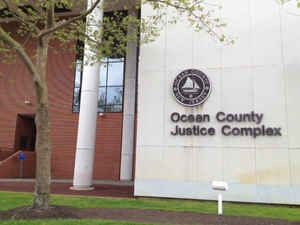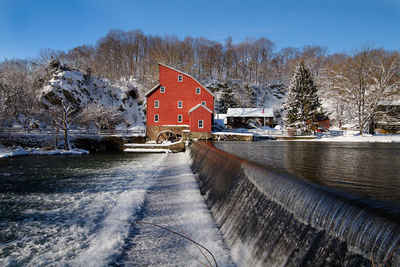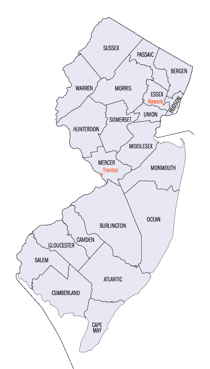New Jersey Counties
New Jersey has twenty-one counties. New Jersey's first counties were created as administrative districts within each province, with East Jersey split in 1675 into Bergen, Essex, Middlesex and Monmouth counties, while West Jersey's initial counties of Burlington and Salem date to 1681. The most recent county created in New Jersey was Union County, created in 1857.Ocean County, New Jersey
Ocean County Education, Geography, and History
Ocean County is a county located along the Jersey Shore in the state of New Jersey. Based on the 2010 census, the
population was 576,567. Ocean County was established on February 15, 1850, from portions of Monmouth County, with the addition of Little Egg
Harbor Township which was annexed from Burlington County on March 30, 1891. Its county seat is Toms River, which, like the county itself, has
been one of the fastest growing areas of the state since the 1990s.
Ocean County is located 50 miles (80 km) east of Philadelphia, 70 miles (110 km) south of New York City, and 25 miles (40 km) north of
Atlantic City, making it a prime destination for residents of these cities during the summer. As with the entire Jersey Shore, summer traffic
routinely clogs local roadways throughout the season.
Ocean County is part of the New York metropolitan area,
Etymology - Origin of Ocean County Name
Ocean is named for its location on the Atlantic Ocean.
Demographics:
County QuickFacts: CensusBureau Quick Facts
Ocean County History
Most historians agree that the Lenni Lenape Indians were the first inhabitants of the Ocean County area. Annually, they migrated from as
far away as Delaware to enjoy the shore and its plentiful food supply. During the Dutch explorations off the New Jersey coast by Captain
Cornelius Hendrickson (1614-1616), Barnegat Bay was discovered and charted. Captain Hendrickson sailed through Barnegat Inlet into the bay on
a small Dutch ship called the "Onrest" from which he charted the Toms River, the forks of Forked River, and Great Bay.
By the end of the 17th century, whalers were at work off the coast. This opened the region to settlement. Soon saw and grist mills flourished
along the streams and rivers leading into the bay.
The whalers, turned smugglers in the first half of the 18th century, were the grandfathers and fathers of the privateers during the American
Revolution. Ocean County endured 23 Loyalist and British attacks on its saltworks, as well as other skirmishes during the Revolution. There
were 77 naval battles off the coast. The largest British naval attack took place in Great Bay in 1778, together with a skirmish against Count
Pulaski's troops east of Tuckerton. This all culminated in an attack on Toms River on March 24, 1782 when the British destroyed the village,
and killed or captured defending militiamen, including Captain Joshua Huddy, who was hanged on April 12, 1782.
On Feb. 15, 1850, Ocean
County came into being. It was then comprised of the townships of Brick, Toms River, Jackson, Plumsted, Stafford, and Union (Barnegat), which,
in the aggregate, had previously been the portion of Monmouth County lying south of the Manasquan River. In 1891, Little Egg Harbor merged
into the new political subdivision. Over time, this vast geographic area was carved into the 33 municipalities.
The 1850 census pegged Ocean County's population at 10,043 residents. One hundred years later it had reached 56,622. Today, as a result of
unprecedented growth in the past three decades, more than 560,000 people call Ocean County home.
Ocean County is the second largest county in the state containing 638 square miles of pine barrens and barrier islands and a 45-mile coastline
along the Atlantic Ocean.
Toms River was selected as the "seat" of the new County government. On May 8, 1850, the first Board of Chosen Freeholders, consisting of two
representatives from each of the six original townships, selected insignia to represent the public officials of the time. The sloop, schooner,
and steamboat are still the official seals of the Freeholders, County Clerk, and Surrogate, respectively. The choice of these symbols reflects
the rich maritime tradition of the area.
One of the first tasks of the Freeholders was to construct a courthouse and a jail. By September of 1851, the new "Greek Revival" style
Courthouse was serving the public' needs. It contained a large second floor courtroom, with ancillary offices on the first floor. The
adjoining County Jail, containing 10 cells, was of compatible architecture. The Sheriff's residence, built in the courtyard behind the
courthouse, remains to this day. Located in the shadow of the present correctional facility, the original jail rarely housed more than two
prisoners at a time, with an annual average of 12 prisoners.
Understandably, the Courthouse quickly became a gathering point for social meetings, political rallies and conventions, as well as a mustering
center during the Civil War. Members of Company F, #14 New Jersey Volunteers, drilled on the grounds of the Courthouse before marching off to
war.
Geography: Land and Water
As reported by the Census Bureau, the county had Based on the 2010 census,a total area of 915.40 square miles (2,370.9 km2), the
second-largest county in New Jersey (behind Burlington County), of which 628.78 square miles (1,628.5 km2) of land (68.7%) and 286.62 square
miles (742.3 km2) of water (31.31%).
Much of the county is flat and coastal, with many beaches. The highest point is one of three unnamed hills (one in Jackson Township, the other
two in Plumsted Township) that reach at least 230 feet (70 m) in elevation. The lowest elevation in the county is sea level.
Neighboring Counties
Bordering counties are as follows:
- Monmouth County, New Jersey - north
- Atlantic County, New Jersey - south
- Burlington County, New Jersey - west
Education
Ocean County College is the two-year community college for Ocean County, one of a network of 19 county colleges statewide. The school is in
Toms River and was founded in 1964.
Georgian Court University in Lakewood is a private Roman Catholic Sisters of Mercy college, which opened in 1908 on the former winter estate
of millionaire George Jay Gould I, son of railroad tycoon Jay Gould. Lakewood is also home to Beth Medrash Govoha, a Haredi Yeshiva with 5,000
students, making it one of the largest yeshivas in the world.
The state's largest suburban school district, Toms River Regional Schools, is located in the county. Toms River is also home to Ocean County's
only Roman Catholic High School, Monsignor Donovan High School, operated by the Roman Catholic Diocese of Trenton, which also has six
elementary schools located in the county.
In addition to multiple public high schools, the county has an extensive vocational high school program, known as the Ocean County Vocational
Technical School district. In addition to its campuses in Brick, Toms River, Waretown, and Jackson, it contains two magnet schools:
Marine Academy of Technology and Environmental Science (MATES)
OCVTS Performing Arts Academy - Theater, Dance, and Vocal







